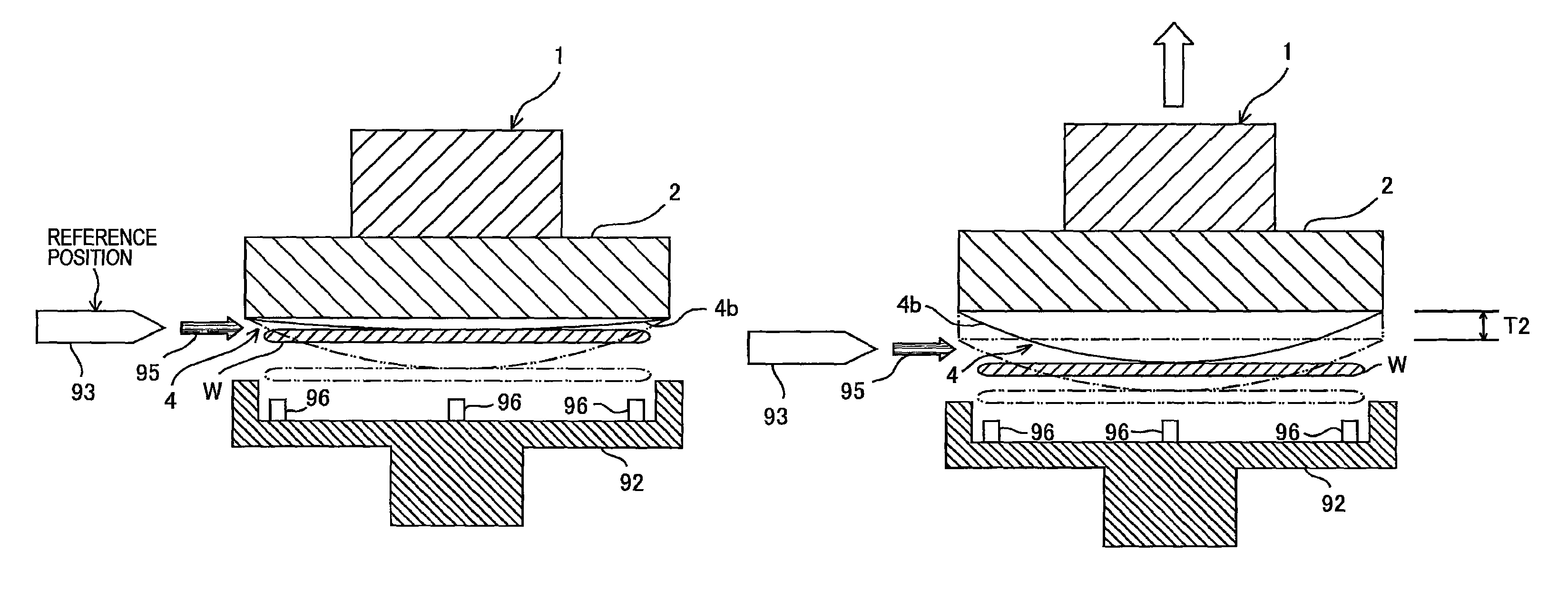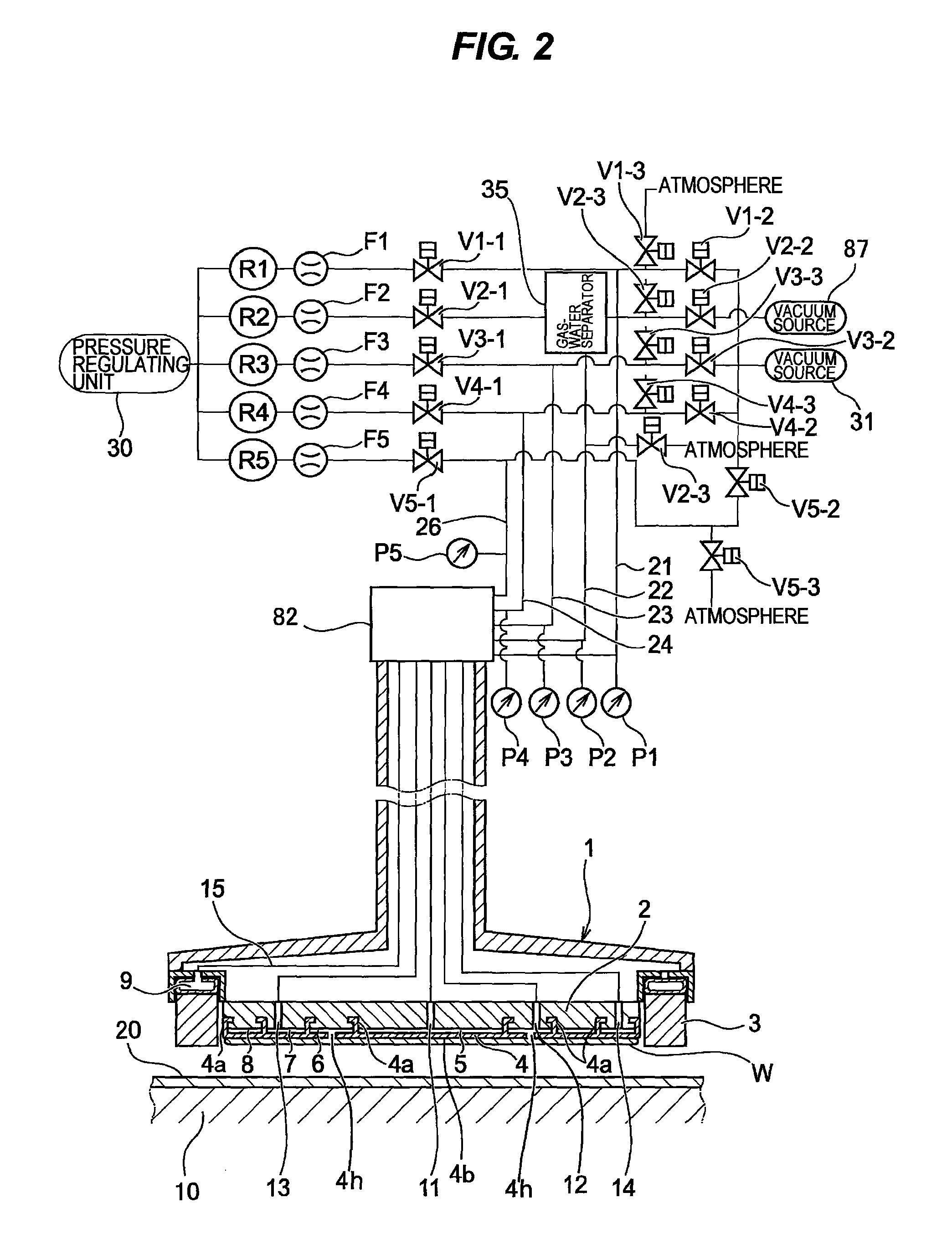Polishing apparatus and polishing method
a technology of polishing apparatus and substrate, which is applied in the direction of grinding machine components, testing/measurement of semiconductor/solid-state devices, manufacturing tools, etc., can solve the problems of “rounded edges”, insufficient polishing or excessive polishing, etc., and achieve the effect of quick and secure release of substra
- Summary
- Abstract
- Description
- Claims
- Application Information
AI Technical Summary
Benefits of technology
Problems solved by technology
Method used
Image
Examples
first embodiment
[0045]FIG. 1 is a schematic view showing an entire structure of a polishing apparatus according to the As shown in FIG. 1, the polishing apparatus includes a polishing table 10, and a top ring (a substrate holder) 1 for holding a substrate, such as a wafer, as an object to be polished and pressing the substrate against a polishing pad 20 on the polishing table 10.
[0046]The polishing table 10 is coupled via a table shaft 10a to a motor (not shown) disposed below the polishing table 10. Thus, the polishing table 10 is rotatable about the table shaft 10a. The polishing pad 20 is attached to an upper surface of the polishing table 10. An upper surface of the polishing pad 20 serves as a polishing surface 20a for polishing a wafer W. A polishing liquid supply nozzle 62 is provided above the polishing table 10 to supply a polishing liquid Q onto the polishing pad 20 on the polishing table 10.
[0047]The top ring 1 includes a top ring body 2 for pressing the wafer W against the polishing su...
second embodiment
[0072]In a second embodiment, the controller 50 may use a cumulative value of the flow rate of the fluid flowing into the central chamber 5 for determining whether or not the wafer W is released from the membrane 4 and / or the amount of stretch h of the membrane 4. The cumulative value of the flow rate from when the releasing operation of the wafer W is started corresponds to the increased volume ΔV of the central chamber 5. Therefore, the amount of stretch h can be calculated by dividing the increased volume ΔV by the horizontal cross-sectional area S of the central chamber 5. The controller 50 calculates the amount of stretch h from the values of ΔV and S and determines the distance T2 from the amount of stretch h. The distance T2 may be equal to or smaller than the amount of stretch h.
[0073]The amount of stretch h can be calculated as follows. First, the valve V1-3 is closed so as to shut off the communication between the passage 21 and the atmosphere. Next, the pressure regulator...
fourth embodiment
[0078]As shown in FIG. 9, the release nozzle 93 is mounted to an elevating device (a vertically moving device) 98, which is configured to elevate and lower the release nozzle 93. Operations of the elevating device 98 are controlled by the controller 50. In the fourth embodiment, instead of elevating the top ring 1, the release nozzle 93 is lowered to a position of the contact portion between the wafer W and the membrane 4. Since the release nozzle 93 is lowered by the distance T2 from the predetermined reference position (see FIG. 3A) while the top ring 1 is not elevated, the fluid 95 from the release nozzle 93 can impinge on the contact portion between the wafer W and the membrane 4 accurately. Therefore, it is possible to release the wafer W from the top ring 1 quickly and reliably. The release nozzle 93 may be disposed below the reference position. In this case, the release nozzle 93 is elevated by the distance T2.
[0079]FIG. 10 shows a fifth embodiment of the polishing apparatus....
PUM
 Login to view more
Login to view more Abstract
Description
Claims
Application Information
 Login to view more
Login to view more - R&D Engineer
- R&D Manager
- IP Professional
- Industry Leading Data Capabilities
- Powerful AI technology
- Patent DNA Extraction
Browse by: Latest US Patents, China's latest patents, Technical Efficacy Thesaurus, Application Domain, Technology Topic.
© 2024 PatSnap. All rights reserved.Legal|Privacy policy|Modern Slavery Act Transparency Statement|Sitemap



